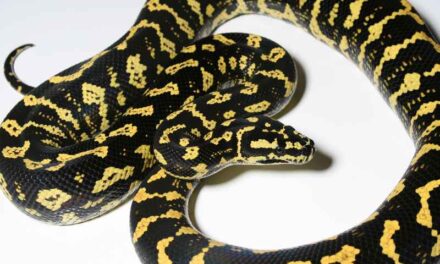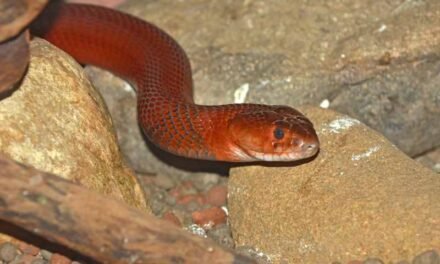The California striped racer is a non-venomous snake that is endemic to southern California, Arizona, and Nevada in the United States as well as Baja California and Sonora in Mexico. The length of an adult red racer may range from 36 to 102 inches (90 to 260 cm), making it a thin species of snake.
The scales that go down the length of their back might be brown, tan, pink, or red, and they have black bands that go around their neck. The bottom is covered with pink scales. It got its name, “coachwhip,” from the distinctive scales that seem like they’ve been braided together like a whip on its tail.
The wide, rocky terrain of the desert is where you’ll most likely find these California striped racers since they tend to avoid locations with extensive flora and forests. They are able to travel swiftly and may be seen crawling through grasses and sagebrush on terrain that is either flat or hilly. A common place for red racers to take refuge is in the crevices and gaps beneath rocks and plants, as well as in the burrows of rodents.
As is the case with other species of snakes, red racers are vicious carnivores that subsist on the meat of other snakes, rodents, lizards, birds, bats, amphibians, and the eggs of birds. Carrion is also consumed, however, the feeding reaction is generally triggered by vision as well as smell, and the consumption of live prey is often favored. The red racer is not a constrictor and does not kill its victim by squeezing it to death as a constrictor would. Instead, it captures its prey and kills it by crushing it in its jaws or pinning it beneath its coils.
The California striped red racer is a cold-blooded reptile, thus, it is able to increase its speed when the temperature is high and the sun is shining. The red racer travels through ground cover by crawling with its head up, and it is also capable of climbing shrubs and trees. As it hunts, the snake will move from side to side and shake its head. In the same way as other types of snakes, red racers often go for warm areas where they can get sunlight, such as roadways. On the roadway, California striped red racers often meet their end when they are run over by tires.
At the beginning of summer, the female red racer lays her eggs. The eggs take between 45 and 70 days to hatch, and the hatchlings are around 13 inches (33 cm) long when they emerge. A California striped racer that has only just been hatched won’t yet have the black stripes that distinguish its neck. Hatchlings will feed on big invertebrates such as insects, spiders, and scorpions before they are able to handle the food of an adult. This is necessary so that they can grow large enough to eat the diet of an adult.
When intimidated, assaulted, or handled roughly, red racers are notorious for their high levels of aggression. The red racer is not poisonous, but it will bite anybody who comes too near it, and it will almost certainly attack anyone who does so. If it has the chance, it will make an attempt to flee as well. Although it is not advised to keep red racers as pets, some individuals do keep them nevertheless.
If you are planning to have the California striped racer as a pet handle them with care
The California striped racer is high-strung, distrustful, and spends a lot of time in defense mode. No, not really. To earn the reptile’s confidence and ultimately make them more submissive, it takes a significant amount of time and effort, and the process must be carried out in small increments. If you want a racer, your best bet is to find one that was bred in captivity, and then go from there. Don’t forget to take baby steps. Those guys would do best in an enclosure with a front entrance.
The following is a selection of the skills I have picked up. Always get up to his eye level while approaching him, and make sure your movements are extremely gradual. Never approach from above. Wash your hands with the same soap the snake is using, so it may develop used to the smell of you. Start working within the cage by moving your palm-down, flat hand toward him in a gentle motion while keeping an eye on his posture.
Move a bit closer with each meeting, and after he is acclimated to your flat palm, let the tongue lightly contact your hand. Move closer with each encounter. That aspect of you is becoming more familiar to him. While you are doing this, try not to make direct eye contact with anybody and glance away occasionally.
As soon as he seems to be at ease with the approach, you may attempt moving around carefully and softly caressing his coils while keeping your hand at the same level as he is. Always have this in the back of your mind: even if you could be bitten, you must not react angrily. It will take some time, but after that, you will be able to begin sliding your fingers under the coils, and eventually, you will be able to remove him carefully from the cage.
Raise him up over your head so that he may be on higher ground when you take him outside to help him feel more at ease. Carry through these steps in small bursts, gradually increasing the amount of time spent on each encounter. After some time has passed, he will eventually come out of his shell and place his whole faith in you. Always work to turn a negative situation into a good one.
In the event that he bites you several times, just spritz a little amount of vinegar over your palm. When he takes a mouthful and tastes it, he will tell you to stop biting, since it tastes awful. After that, you’ll be able to start again. Building trust and making things easier to handle are the goals of this strategy. You are free to use hooks and control the California striped racer in any way you see fit; but, in order to build a trusting relationship with him, it must be done on his terms.









